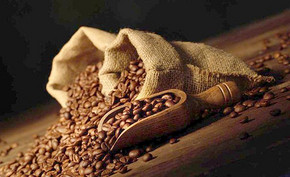What are the categories of Robusta coffee beans
In fact, Robusta is also divided into many categories, can not be generalized or blindly pursue the price. Among the big coffee countries, Robusta's major producers are Vietnam, Brazil, Indonesia, India and so on. Like Arabica, Robusta in each country has a corresponding hierarchy. According to different grades, we can see the general quality standard of raw beans.
Today is a question rarely discussed in the coffee world: how is Robusta coffee graded?
Brazil
In Brazil, Robusta's output is called Conillon. Geographically, the main coffee producing areas of Robusta are:
Espirito Santo, Esp í rito Santo
Mato Grosso, Mato Grosso State
-South Bahia, Bahia (Sul da Bahia)
Rond ô nia, Londonia
Robusta is usually graded according to particle size:
4 take 5 (screen 14 to 17 +)
5Accord 6 (as of screen 13)
6 (as of screen 12)
Tanzania
Classification according to particle size
Grade
Particle size
Superior
95% greater than 16 mesh
FAQ & SUG
95% greater than 14 mesh
UG
90% greater than 13 mesh
Triage
Equivalent to a real-time sample provided by the Tanzania Coffee Council
FAQ: Fair Average Quality with good quality
Indonesia
Classification according to defect rate
Grade
Standard
G1
The total defect is less than 11
G2
Total defects are greater than 12 and less than 25
G3
Total defects greater than 26 and less than 44
G4
The total defect is more than 45 and less than 80
G5
Total defects greater than 81 and less than 150
G6
Total defects greater than 151 and less than 225
Classification according to particle size
Sun Robusta
Size
Standard
Big
95% above 16 mesh (6.5mm)
Small
95% are below 16 mesh (6.5mm) and above 9 mesh (3.5mm)
Wash Robusta
Size
Standard
Big
95% above 19 mesh (7.5mm)
Medium
95% below 19 items (7.5mm)
More than 16 items (6.5mm)
Small
95% below 16 items (6.5mm)
More than 14 mesh (5.5mm)
Classify according to treatment
Indonesia's Robusta is famous all over the world. The main treatment methods are dry treatment and wet treatment.
Dry treatment usually refers to washing with hot water after insolation. This kind of coffee beans is called A.P. (After Polished).
When Robusta is treated in the traditional way, it is called wet treatment. It is usually determined by the quality of the processing:
EK1 (Dutch: & # 39 world erst Kwaliteit' = first quality) High quality
G.B. (Dutch: & # 39 × Gewone Bereiding' = simple preparation) minimalist standard
O.I.B. (Dutch: & # 39 th Oost Indische Bereiding' = East-Indian preparation) East Indian standard
W.I.B. (Dutch: & # 39 th West Indische Bereiding' = West-Indian preparation) West Indian standard
W.I.B. It is the highest standard and the most common one.
At present, the new classification method uses defect rate for classification. In practice, however, the new and old standards are actually used at the same time.
India
Classified by defect rate
Washing Robusta is graded as follows:
Parchment PB
Parchment AB
Parchment C
Parchment Black/browns
Parchment Bits
Parchment Bulk
Sun Robusta grades are as follows:
Cherry PB
Cherry AB
Cherry C
Cherry Black/browns
Cherry Bits
Cherry Bulk
Classify by particle size
Washing classification
Raw bean size (mm) / mesh
Parchment PB
-
Parchment AB
6.00 / 15
Parchment C
5.50 / 14
Sun grading
Raw bean size (mm) / mesh
Robusta Cherry PB
-
Robusta Cherry AB
6.00 / 15
Robusta Cherry C
5.50 / 14
Viet Nam
Vietnam Robbins Tadou is divided into only three levels: G1Magol G2 and G3. It is mainly divided according to defects.
For each grade, the official criteria for raw bean size are as follows:
Grade 1: > 7mm
Grade 2: > 6-7 mm
Grade 3: > 5mm
In practical application, the widely used sieve mesh data for particle measurement will also be provided.
G1 Vietnam Robusta is often labeled as 16 mesh (90% 16 mesh or more) or 18 mesh (90% 18 mesh or more).
In order to make it easier to compare with Indonesian standards, the classification criteria are as follows (released in November 2001):
Robusta bean
Special Grade
G1
G2
G3
G4
G5
Papua New Guinea
Classification according to defects
Grade
Particle
Bean shape
Bean color
smell
Baking
Cup test quality
FAQ
Mix
Blend shap
Green
clean
Hybrid
The flavor is medium but not prominent.
T
Mix
Blend shap
Green to brown
There is no rotten and miscellaneous taste
Hybrid
There is no rotten and miscellaneous taste
Important Notice :
前街咖啡 FrontStreet Coffee has moved to new addredd:
FrontStreet Coffee Address: 315,Donghua East Road,GuangZhou
Tel:020 38364473
- Prev

The tasty Robusta recommends
Following Cafe (official Wechat account vdailycom) found that Fairview Cafe opened its own shop like other coffee growing areas in the world. Indian farmers chose robusta beans as the last choice to grow coffee varieties, and chose to grow robusta beans only when the soil was not suitable for growing Arabica beans, because robusta beans are traded on the New York Stock Exchange.
- Next

Indian "Coffee Royal" Grade Introduction to Robusta
Pay close attention to the coffee review (Weixin Official Accounts vdailycom ) and find that the beautiful coffee shop has opened its own small shop. At present, the output of Indian coffee royal grade Robusta is still very small, but it has gradually attracted the attention of the elite coffee industry all over the world. Italian coffee expert David Schumann David C. Schomer's Espresso Vivace store in Seattle, USA, opened ten years ago
Related
- Detailed explanation of Jadeite planting Land in Panamanian Jadeite Manor introduction to the grading system of Jadeite competitive bidding, Red bid, Green bid and Rose Summer
- Story of Coffee planting in Brenka region of Costa Rica Stonehenge Manor anaerobic heavy honey treatment of flavor mouth
- What's on the barrel of Blue Mountain Coffee beans?
- Can American coffee also pull flowers? How to use hot American style to pull out a good-looking pattern?
- Can you make a cold extract with coffee beans? What is the right proportion for cold-extracted coffee formula?
- Indonesian PWN Gold Mandrine Coffee Origin Features Flavor How to Chong? Mandolin coffee is American.
- A brief introduction to the flavor characteristics of Brazilian yellow bourbon coffee beans
- What is the effect of different water quality on the flavor of cold-extracted coffee? What kind of water is best for brewing coffee?
- Why do you think of Rose Summer whenever you mention Panamanian coffee?
- Introduction to the characteristics of authentic blue mountain coffee bean producing areas? What is the CIB Coffee Authority in Jamaica?

